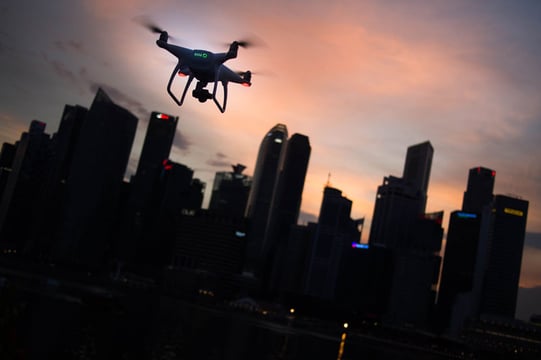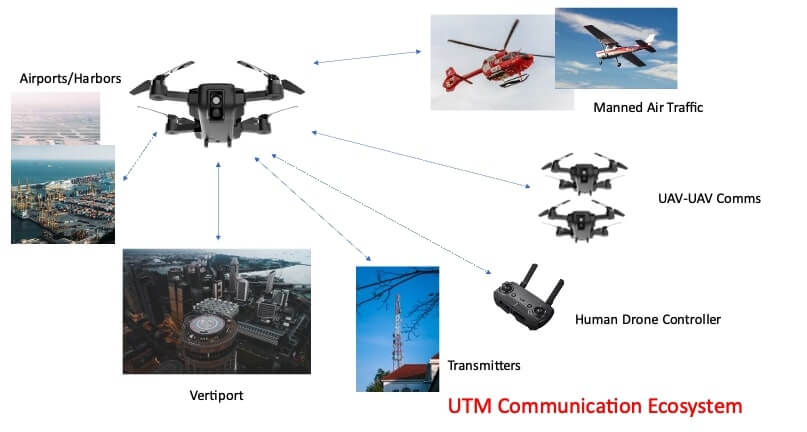Why spectrum monitoring is critical for urban UTM operations

Interference with wireless technology. Limited spectrum. Spectrum sharing. Regulatory compliance. Unmanned aerial vehicles (UAVs), better known as drones, pose a raft of challenges for spectrum managers regulating the use of the electromagnetic spectrum (EMS). And the recent increase in UAVs has led to the development of unmanned traffic management (UTM) systems to regulate and manage airspace to help ensure safe and efficient drone operations.
Concerns around UTM spectrum requirements in urban environments?
In urban areas, UTM spectrum concerns are becoming increasingly important due to the potential for UAVs to interfere with existing air traffic, vertiports, buildings, and civil transmissions in dense “urban canyons”. As UAVs are gradually becoming completely autonomous, protecting communications between drones and air traffic control becomes paramount. The danger of multipath in “urban canyons” is clear. Within this environment, spectrum monitoring plays a critical role in ensuring the safety and efficiency of UTM both for Visual Line of Sight (VLOS) and Beyond Visual Line of Sight (BVLOS) operations.
What are the five key functions of UTMs?
- Manage the airspace used by drones, including identifying restricted or no-fly zones.
- Enable drone operators to plan flights and obtain necessary permissions. This could include identifying safe flight paths, coordinating with other airspace users, and obtaining necessary approvals from regulatory authorities.
- Provide real-time tracking of drones, enabling drone operators and air traffic controllers to monitor drone operations and respond quickly to any safety or security issues.
- Promote technologies that help prevent drones from colliding with other drones or manned aircraft.
- Enable communication between drone operators, air traffic controllers, and other stakeholders involved in drone operations.
What is spectrum monitoring?
Spectrum monitoring refers to the process of continuously monitoring the radio frequency spectrum to detect and locate sources of electromagnetic interference (EMI) and other signals. Spectrum monitoring professionals use passive radio frequency receivers to listen to the spectrum and watch for changes. Spectrum monitoring is not just a government responsibility, as private sector firms like airports, harbors, and sporting events employ this technology to keep their communications safe.
In the context of UTM, spectrum monitoring is essential for ensuring that UAVs can operate safely and without interference from other radio signals in the urban environment. Spectrum monitoring also protects normal spectrum users of shared UAV spectrum, such as 5G.

UAVs and Spectrum Sharing
According to research, spectrum sharing between UAVs and other network topologies will become critically important to increase spectrum use efficiency. There are three categories of UAV sharing, which can increase channel capacity and security and be applied to existing infrastructure.
- Underlay sharing: concurrent parallel sharing over unused bands
- Overlay sharing: explicit opportunistic or cooperative sharing across unused bands
- Interweave sharing: explicit use of fragmented bands
Monitoring and occupancy reporting will continue to be vital to ensure spectrum sharing works properly and during pre-deployment planning. Specialist software can be used to conduct automated and scheduled occupancy reports.
Three reasons spectrum monitoring is important for urban UTM
- First, UAVs rely on radio communication systems/protocols (C-Band, ADS-B, Wifi, 5G, 6G, MANET) to transmit and receive data from ground stations and between other UAVs. Spectrum monitoring sensors can detect and locate sources of interference through passive signal geolocation that may disrupt these communication links, allowing UTM operators or air traffic controllers to take action to rapidly mitigate the problem.
Spectrum monitoring can also look out for multipath effects—a phenomenon that results in a radio signal being diffracted and reflected by physical objects, like buildings, vehicles, and trees. Furthermore, ADS-B Spoofing detection is also vitally important to flight safety within UTM operations. - Second, spectrum monitoring detects and locates sources of EMI that may interfere with other critical communication systems, such as those used by emergency services, the military, or air traffic control. By detecting and locating these sources of interference, UTM service providers can take action to ensure that these critical communication systems continue to function properly.
It is important to remember that pre-deployment occupancy reports and surveys can determine spectrum saturation and usage during UTM route planning. This helps decrease the risk of future interference as the UTM system is installed and commissioned. - Third, spectrum monitoring systems detect and locate UAVs that are operating outside designated areas or without proper authorization. By detecting these unauthorized (or rouge) UAVs, UTM operators can take action to prevent them from interfering with other aircraft or communication systems. Drone detection missions can also be conducted in tandem with spectrum monitoring tasks, which increases the usage of an RF system deployment.
Video: Understanding multipath RF for direction finding
Integration of spectrum monitoring into UTM control centers
Modern spectrum monitoring technology should integrate seamlessly into UTM command and control systems through JSON APIs, enabling spectrum data (line of bearing, UAV geolocations, jamming alarms) to be displayed on common operating pictures. This means that air traffic controllers, ANSPs, and other UTM authorities can respond quickly to interference or degraded communications, plus track unauthorized drones through the use of geofences and signal geolocations.
An agile approach to UTM spectrum monitoring
A deployable spectrum monitoring system based on agile Nodes and Arrays can be easily placed on rooftops or towers. Linked together through low bandwidth networking, Nodes and Arrays enable remote and automated spectrum monitoring with the option for easy API integration through JSON messaging. This means that drone detections can be streamed through ASTERIX ATC data or TCP/IP and displayed on a UTM operation center’s common operating picture (COP). Automated spectrum baselines from Nodes assist in pre-system deployment and commissioning and ensure UTM communications are monitored 24/7.
Conclusion
Spectrum monitoring is essential for ensuring the safe and efficient operation of UTM in urban areas. By continuously monitoring the radio frequency spectrum, UTM operators can detect and locate sources of interference and take appropriate action to mitigate the problem. As the number of UAVs in urban areas continues to grow, the importance of spectrum monitoring for UTM will only continue to increase.
Zac George
Zac George is the International Business Development Manager for CRFS. He is a former naval Electronic Warfare officer and also has experience in digital decoding. He speaks regularly on EW and spectrum topics globally, and lives in Switzerland.
